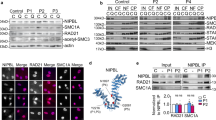Abstract
Roberts syndrome is an autosomal recessive disorder characterized by craniofacial anomalies, tetraphocomelia and loss of cohesion at heterochromatic regions of centromeres and the Y chromosome. We identified mutations in a new human gene, ESCO2, associated with Roberts syndrome in 15 kindreds. The ESCO2 protein product is a member of a conserved protein family that is required for the establishment of sister chromatid cohesion during S phase and has putative acetyltransferase activity.

Similar content being viewed by others
Accession codes
References
Van Den Berg, D.J. & Francke, U. Am. J. Med. Genet. 47, 1104–1123 (1993).
German, J. Clin. Genet. 16, 441–447 (1979).
Ivanov, D. et al. Curr. Biol. 12, 323–328 (2002).
Skibbens, R.V., Corson, L.B., Koshland, D. & Hieter, P. Genes Dev. 13, 307–319 (1999).
Tóth, A. et al. Genes Dev. 13, 320–333 (1999).
Tanaka, K. et al. Mol. Cell. Biol. 20, 3459–3469 (2000).
Williams, B.C. et al. Curr. Biol. 13, 2025–2036 (2003).
Bellows, A.M., Kenna, M.A., Cassimeris, L. & Skibbens, R.V. Nucleic Acids Res. 31, 6334–6343 (2003).
Petronczki, M., Siomos, M.F. & Nasmyth, K. Cell 112, 423–440 (2003).
Jabs, E.W., Tuck-Muller, C.M., Cusano, R. & Rattner, J.B. Chromosoma 100, 251–261 (1991).
Tomkins, D.J. & Sisken, J.E. Am. J. Hum. Genet. 36, 1332–1340 (1984).
Burns, M.A. & Tomkins, D.J. Mutat. Res. 216, 243–249 (1989).
Gimenez-Abian, J.F. et al. Curr. Biol. 14, 1187–1193 (2004).
Hoque, M.T. & Ishikawa, F. J. Biol. Chem. 277, 42306–42314 (2002).
Tomkins, D., Hunter, A. & Roberts, M. Am. J. Med. Genet. 4, 17–26 (1979).
Acknowledgements
We thank the families with Roberts syndrome for their interest and cooperation; D. Tomkins for R22 sample; Biobank at the Istituto Giannina Gaslini for R34 sample; and M. Camargo for technical support. H.V. was supported by scholarships from the Japanese Ministry of Education, Culture, Sports, Science and Technology and the Instituto Colombiano para el Desarrollo de la Ciencia y la Tecnologia. M.G. is supported by the Smile Train Fellowship award to the Center for Craniofacial Development and Disorders at Johns Hopkins University. M.G. and E.W.J. were supported by the Louis H. Gross Foundation, J.S. Sutland and L. and S. Pakula. Q.W. was supported by the Netherlands Organization for Health Research and Development.
Author information
Authors and Affiliations
Corresponding authors
Ethics declarations
Competing interests
The authors declare no competing financial interests.
Supplementary information
Supplementary Fig. 1
Mutations in ESCO2 in 15 RBS families. (PDF 55 kb)
Supplementary Fig. 2
Map of the genomic region between markers D8S1771 and D8S1820 and gene structure and tissue expression of ESCO2. (PDF 2548 kb)
Supplementary Fig. 3
Multiple protein sequence alignment of ESCO2 vertebrate orthologs. (PDF 1346 kb)
Supplementary Fig. 4
Multiple sequence alignment of the Eco1p domain in different species. (PDF 172 kb)
Supplementary Fig. 5
Mitotic spindle checkpoint study in RBS cells. (PDF 1059 kb)
Rights and permissions
About this article
Cite this article
Vega, H., Waisfisz, Q., Gordillo, M. et al. Roberts syndrome is caused by mutations in ESCO2, a human homolog of yeast ECO1 that is essential for the establishment of sister chromatid cohesion. Nat Genet 37, 468–470 (2005). https://doi.org/10.1038/ng1548
Received:
Accepted:
Published:
Issue Date:
DOI: https://doi.org/10.1038/ng1548
- Springer Nature America, Inc.
This article is cited by
-
Application of neural network-based image analysis to detect sister chromatid cohesion defects
Scientific Reports (2023)
-
The multifaceted roles of cohesin in cancer
Journal of Experimental & Clinical Cancer Research (2022)
-
Prenatal diagnosis of Roberts syndrome in a Chinese family based on ultrasound findings and whole exome sequencing: a case report
BMC Medical Genomics (2022)
-
The emerging role of chromatin remodelers in neurodevelopmental disorders: a developmental perspective
Cellular and Molecular Life Sciences (2021)
-
Alternative catalytic residues in the active site of Esco acetyltransferases
Scientific Reports (2020)





